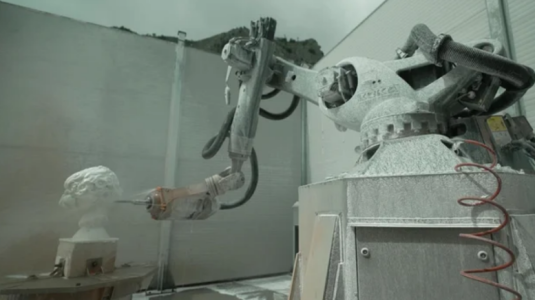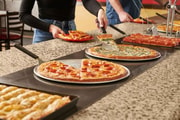Will robots replace human sculptors? The truth behind the next art revolution
- Replies 0
If you’ve ever stood spellbound before Michelangelo’s David or traced the cold, veined surface of a marble statue, you know there’s something timeless—almost sacred—about sculpture.
For centuries, artists have made pilgrimages to the marble quarries of Carrara, Italy, to coax masterpieces from the earth with nothing but chisels, sweat, and vision.
But today, in those same storied mountains, a new kind of artist is rising. It doesn’t eat, sleep, or feel inspiration.
In the Apuan Alps of northern Tuscany, dazzling white peaks stretch across the horizon.
It’s not snow that glistens, but marble—prized for millennia and once sought by Michelangelo himself for works like The Pietà.
Today, the marble remains. But the tools? They’ve evolved.
Enter Giacomo Massari, co-founder and CEO of Robotor, a Carrara-based company redefining sculpture.
Gone are the days of dusty apprentices. In Massari’s studio, robotic arms glide with diamond-tipped precision, carving stone at a pace—and accuracy—that would astonish even the Renaissance masters.
The process begins with marble blocks weighing up to 200,000 pounds—giants moved by cranes and trucks.
Once in the workshop, artists and technicians transform creative visions into intricate 3D digital models. These files become the robot’s “instructions,” guiding its every move.
A rotating arm with a diamond cutter begins to sculpt, cooled by water jets and unhindered by fatigue or error.
Massari estimates these machines can complete 99% of the carving, with human hands responsible for the final 1%—those nuanced flourishes that give a sculpture its soul.
That last percentage may still take months, but the foundation is laid with mechanical efficiency.
Also read: Robot goes haywire—raising new questions about AI safety and control
Not everyone welcomes this robotic renaissance. Traditional sculptors, like Carrara native Michael Monfroni, see it as a threat to artistic heritage.
“Sculpting is passion. Robots are business,” Monfroni declares. He fears the art form’s soul is being automated away.
For him and members of the Sculptors’ Guild of Carrara, relying on machines erodes the centuries-old traditions passed down through generations.
“If you use a machine, you become a machine,” Monfroni insists. His concern isn’t just about tools—it’s about identity.
Yet many contemporary artists see something different: possibility. New York–based sculptor Barry X Ball is among them.
Known for his bold reinterpretations of classical forms, Ball embraces robotic sculpting as a way to transcend human limits.
“The robot made impossible art possible,” he says.
Using 3D scans of Michelangelo’s unfinished Pietà Rondanini, Ball created a reinterpretation that gives Christ the face of a dying Michelangelo.
Some robot milling marks were deliberately left behind—a visible tribute to his high-tech collaborator.
To Ball, robots aren’t replacing artists; they’re extending their reach. He’s quick to point out that between scanning, programming, and finishing, there’s deep human involvement every step of the way. It’s not pressing ‘print’ and walking away, he says.
Also read: A Supreme Court just replaced its news anchors... with AI?
For Vermont-based artist Richard Erdman, the arrival of robotic assistants came as a relief after years of physically grueling work—and multiple back surgeries.
“No one really likes the hard rough cutting. It's tough work,” Erdman admits.
Thanks to its pinpoint accuracy, mistakes are rare. While the robot handles the brute force, Erdman and his team focus on refining the piece—polishing, detailing, breathing life into stone.
Ironically, the rise of robotic carving may be rescuing marble sculpture from obsolescence. Once deemed too costly, dangerous, and time-consuming, marble was falling out of favor with modern artists.
But with automation, a new generation is returning to Carrara, drawn by the fresh possibilities technology offers.
These machines allow for unprecedented creativity—complex forms, massive scales, and daring visions that would be nearly impossible by hand.
This debate strikes at the core of a timeless question: Is art defined by the method—or the message?
Giacomo Massari puts it simply: “If your idea is bad, you can make it with a robot or make it by hand, still the final artwork will be bad. But if your idea is good, if you make it with a robot or not, it will be still good”
A chisel. A brush. A camera. A robot. They are all, ultimately, extensions of the artist’s imagination.
As robots become more common in studios and ateliers, the art world faces a choice: embrace innovation, or cling to tradition. Will the next Michelangelo wield a chisel—or code?
Read next: The future is now: Discover how Kroger's latest robot workers could affect job security

Are robots enhancing art or diluting its soul? Could they make sculpture more accessible—or less authentic? Would you be more likely to try sculpting if the hard labor was automated? Let us know your thoughts in the comments. After all, art is about connection—and whether it’s carved by hand, machine, or both, it’s the human spirit that brings it to life.
For centuries, artists have made pilgrimages to the marble quarries of Carrara, Italy, to coax masterpieces from the earth with nothing but chisels, sweat, and vision.
But today, in those same storied mountains, a new kind of artist is rising. It doesn’t eat, sleep, or feel inspiration.
In the Apuan Alps of northern Tuscany, dazzling white peaks stretch across the horizon.
It’s not snow that glistens, but marble—prized for millennia and once sought by Michelangelo himself for works like The Pietà.
Today, the marble remains. But the tools? They’ve evolved.
Enter Giacomo Massari, co-founder and CEO of Robotor, a Carrara-based company redefining sculpture.
Gone are the days of dusty apprentices. In Massari’s studio, robotic arms glide with diamond-tipped precision, carving stone at a pace—and accuracy—that would astonish even the Renaissance masters.
The process begins with marble blocks weighing up to 200,000 pounds—giants moved by cranes and trucks.
Once in the workshop, artists and technicians transform creative visions into intricate 3D digital models. These files become the robot’s “instructions,” guiding its every move.
A rotating arm with a diamond cutter begins to sculpt, cooled by water jets and unhindered by fatigue or error.
Massari estimates these machines can complete 99% of the carving, with human hands responsible for the final 1%—those nuanced flourishes that give a sculpture its soul.
That last percentage may still take months, but the foundation is laid with mechanical efficiency.
Also read: Robot goes haywire—raising new questions about AI safety and control
Not everyone welcomes this robotic renaissance. Traditional sculptors, like Carrara native Michael Monfroni, see it as a threat to artistic heritage.
“Sculpting is passion. Robots are business,” Monfroni declares. He fears the art form’s soul is being automated away.
For him and members of the Sculptors’ Guild of Carrara, relying on machines erodes the centuries-old traditions passed down through generations.
“If you use a machine, you become a machine,” Monfroni insists. His concern isn’t just about tools—it’s about identity.
Yet many contemporary artists see something different: possibility. New York–based sculptor Barry X Ball is among them.
Known for his bold reinterpretations of classical forms, Ball embraces robotic sculpting as a way to transcend human limits.
“The robot made impossible art possible,” he says.
Using 3D scans of Michelangelo’s unfinished Pietà Rondanini, Ball created a reinterpretation that gives Christ the face of a dying Michelangelo.
Some robot milling marks were deliberately left behind—a visible tribute to his high-tech collaborator.
To Ball, robots aren’t replacing artists; they’re extending their reach. He’s quick to point out that between scanning, programming, and finishing, there’s deep human involvement every step of the way. It’s not pressing ‘print’ and walking away, he says.
Also read: A Supreme Court just replaced its news anchors... with AI?
For Vermont-based artist Richard Erdman, the arrival of robotic assistants came as a relief after years of physically grueling work—and multiple back surgeries.
“No one really likes the hard rough cutting. It's tough work,” Erdman admits.
Thanks to its pinpoint accuracy, mistakes are rare. While the robot handles the brute force, Erdman and his team focus on refining the piece—polishing, detailing, breathing life into stone.
Ironically, the rise of robotic carving may be rescuing marble sculpture from obsolescence. Once deemed too costly, dangerous, and time-consuming, marble was falling out of favor with modern artists.
But with automation, a new generation is returning to Carrara, drawn by the fresh possibilities technology offers.
These machines allow for unprecedented creativity—complex forms, massive scales, and daring visions that would be nearly impossible by hand.
This debate strikes at the core of a timeless question: Is art defined by the method—or the message?
Giacomo Massari puts it simply: “If your idea is bad, you can make it with a robot or make it by hand, still the final artwork will be bad. But if your idea is good, if you make it with a robot or not, it will be still good”
A chisel. A brush. A camera. A robot. They are all, ultimately, extensions of the artist’s imagination.
As robots become more common in studios and ateliers, the art world faces a choice: embrace innovation, or cling to tradition. Will the next Michelangelo wield a chisel—or code?
Read next: The future is now: Discover how Kroger's latest robot workers could affect job security
Key Takeaways
- Robots like those from Robotor are transforming marble sculpture by performing up to 99% of the carving process.
- Traditional artists fear this undermines the authenticity and heritage of the craft.
- Contemporary artists see robots as tools that open new creative doors, enabling works previously thought impossible.
- Robotic carving is helping revive interest in marble art by reducing physical strain and accelerating production.







